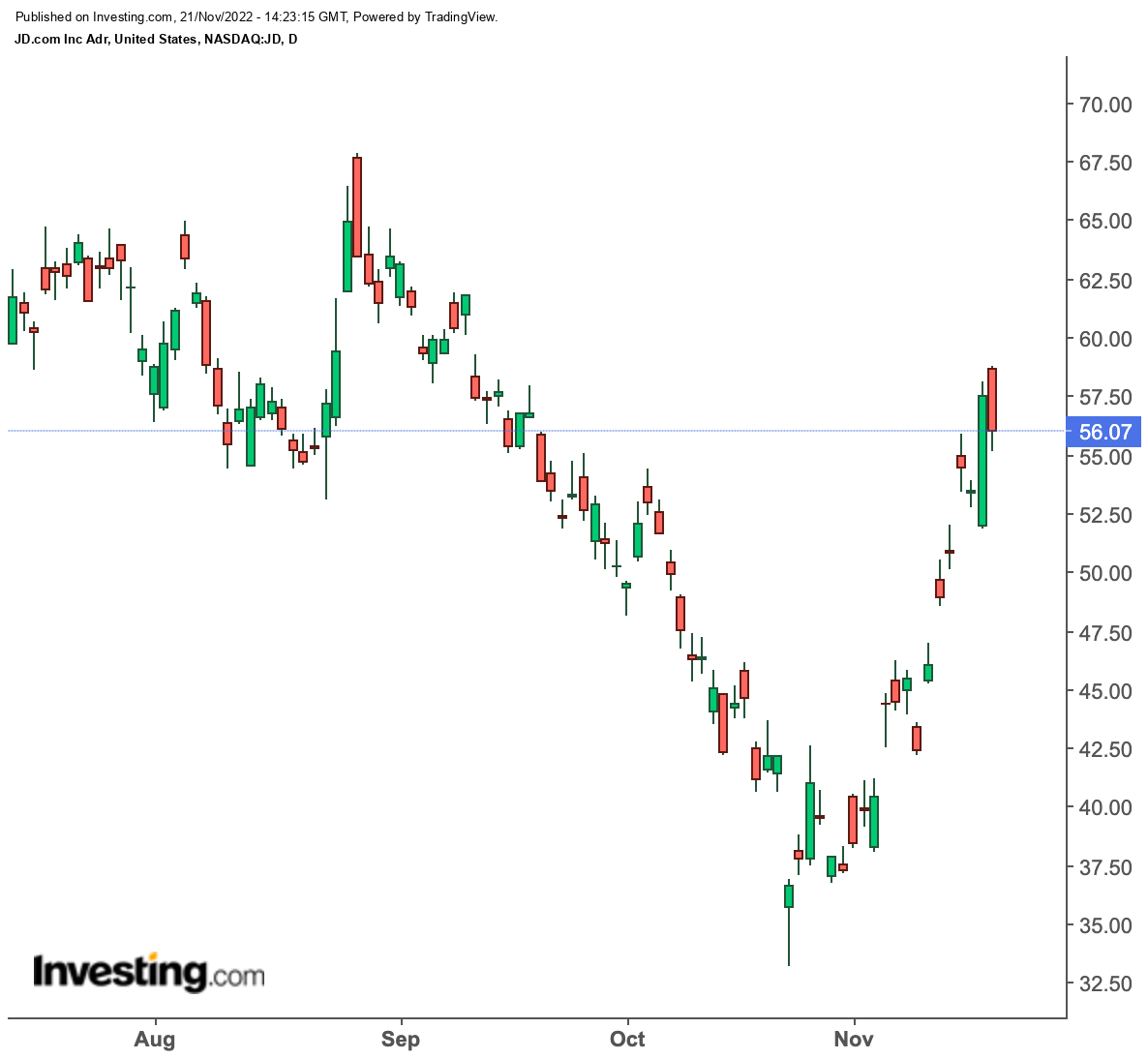JD.com Is a Solid Pick for Those Willing to Take the China Risk
2022.11.21 12:26
[ad_1]
- Along with peers, JD stock has rebounded sharply from last month’s lows.
- The gains make some sense, given strong earnings and an attractive valuation.
- Country risks are obvious; however, investors willing to take those risks should take a look at JD.
What a difference a month makes. Four weeks ago, JD.com (NASDAQ:) stock touched a two-year low as shares fell 13% in a single session amid fears that new leadership in China created a mid-term risk to the country’s economic growth.
Since that close, however, JD has rallied a sparkling 53%. Peers Alibaba (NYSE:) and Pinduoduo (NASDAQ:), too, have gained. A more bullish US market has helped, but the bigger driver seems to be a perception that Chinese retailers have become simply too cheap.

After that rally, it’s tempting, perhaps, to believe the opportunity has passed. That’s not necessarily the case. JD’s performance in a tough environment remains impressive. Yet even with the bounce from last month’s lows, JD’s valuation still looks attractive.
The risks here are obvious. The Chinese economy still looks wobbly amid of a housing bubble. Foreign investors in JD.com still don’t technically own the business but rather a holding company domiciled in the Cayman Islands. (See page 6 of the most recent 20-F filing for further detail.)
For some investors, those risks make JD a no-go. For the rest, the stock should be worth at least a long look.
Strong Q3 Earnings
On its face, JD.com’s looks impressive. Revenue increased 11% year-over-year. Adjusted operating profit more than doubled.
But in context, the report is even better than the headlines suggest. JD.com had a tough comparison: revenue increased 25% in the year-prior quarter. Operating income admittedly declined in Q3 2021, but on a two-year basis, Q3 2022 operating profit rose 77%.
And, of course, the results came amid a challenging operating environment. COVID lockdowns to impact demand, as well as increasing costs. Yet JD.com expanded profit margins nicely in the quarter as the company reaped the fruits of past investments.
JD Stock Looks Cheap
Despite the strength shown in Q3, and even after the recent rally, JD shares look cheap. Over the past four quarters, per the third quarter earnings release, free cash flow totaled $3.6 billion.
That, in turn, suggests a price-to-free cash flow multiple of roughly 24x. But even that multiple understates the attractiveness of the valuation. JD also closed Q3 with about $24 billion in cash on its balance sheet, net of debt. Back out that net cash and P/FCF drops to about 17x.
That’s a light multiple for a business growing at this kind of clip. And it’s a light multiple for a company with the opportunity JD.com has going forward.
It’s not a surprise that the average Wall Street analyst has a 12-month price target of $78, suggesting a 39% upside from here.
Why JD.com Can Keep Growing
Over the past few years, JD.com has made an impressive effort to build out its capabilities, most notably in logistics. Unlike Alibaba, which operates mainly as a marketplace, JD.com owns and ships its inventory.
Those investments, and those capabilities, have given JD.com an edge over its larger rival. As a result, the company has taken market share in recent years.
That trend should continue going forward, particularly once some level of normalcy returns to Chinese life. Meanwhile, JD Logistics is becoming a significant source of growth: revenue increased 39% year-over-year in Q3.
The opportunity in Asia obviously is massive: JD.com has nearly 600 million active customers, yet plenty of room for further growth. The logistics network should help the company best serve those customers while also providing a base for margin expansion in the future, which will drive consistent profit growth.
Look Out for the Risks
It bears repeating: this is not a perfect story. The country and governance risks are real.
And competition is another factor. This summer, I that Pinduoduo looked like the best play in large-cap China retail. With PDD stock only marginally higher since then, that seems likely to still be the case.
But PDD has its own risks and a much higher valuation after a 20% year-to-date gain. JD.com looks like a lower-risk option, at least on a relative basis. All told, there’s a nice case here — for investors willing to invest in China at all.
Disclosure: As of this writing, Vince Martin has no positions in any securities mentioned.
[ad_2]








